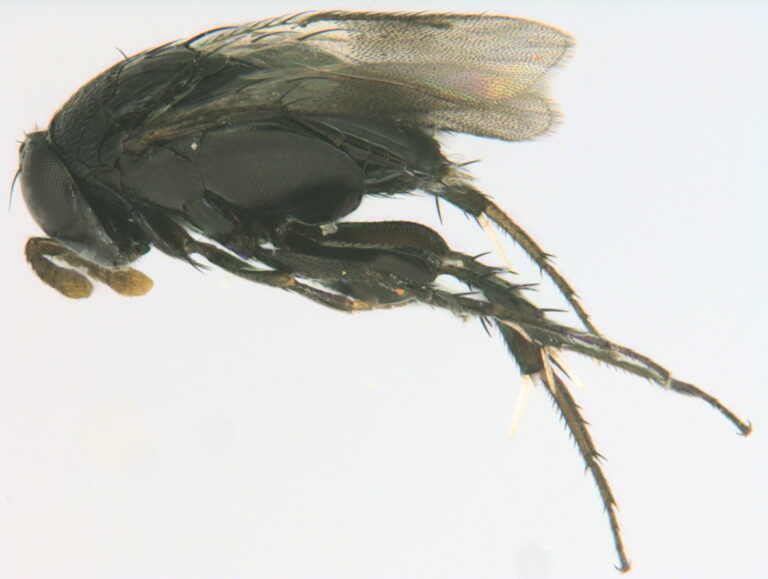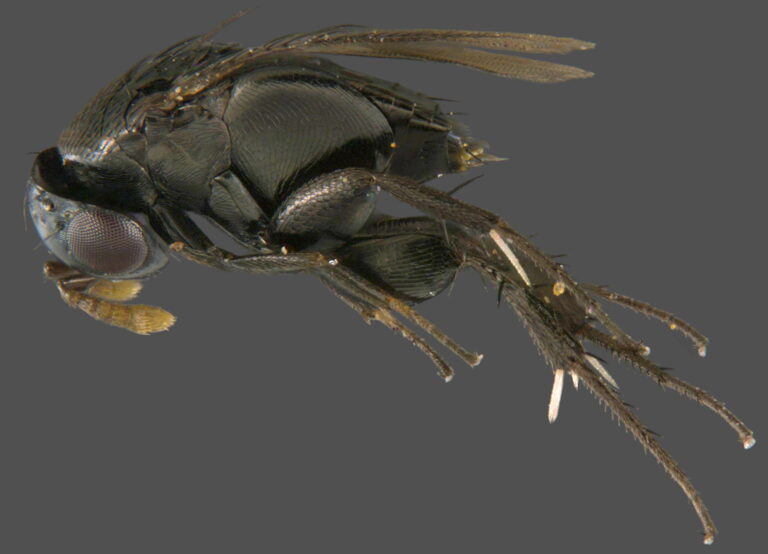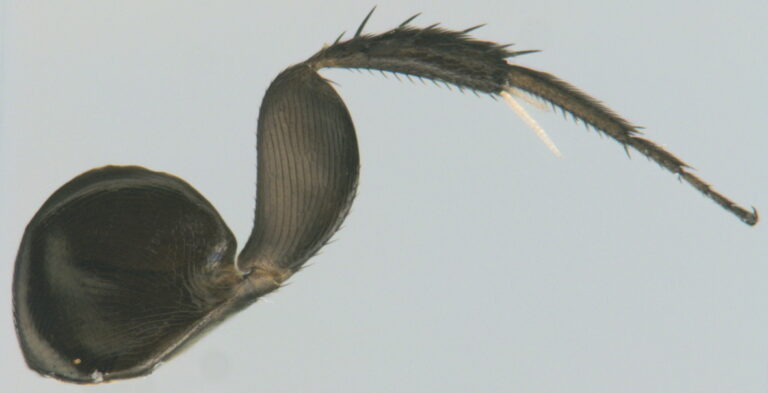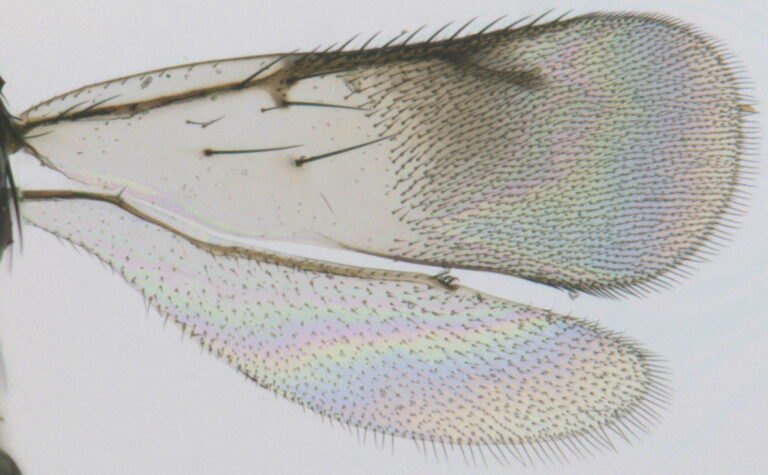
Euryischia Riley (Hymenoptera: Pirenidae: Euryischiinae) is a small genus with only 13 known species (Noyes, 2019). It is listed as belonging to the family Eriaporidae in the Universal Chalcidoidea Database (Noyes, 2019); however, Eriaporidae is now synonymized with Pirenidae, which itself was part of the family Pteromalidae earlier (Burks et al. 2022). Most of these species are distributed in Australia with one species known from each of the Oriental, Palaearctic, and Afro-tropical regions. Only Euryischia indica Mani & Kurian, 1953 is known in India from Andhra Pradesh, Tamil Nadu, Bihar, and Uttar Pradesh (Hayat, 1998; Noyes, 2019). Species of Euryschia are reported to be either hyperparasitoids on entomophagous Diptera or fly puparia associated with or collected with various Coccoidea (Hayat, 1998). Euryischia indica has been recorded on Pseudococcus sp. (Sternorrhyncha: Coccoidea: Pseudococcidae), Icerya seychellarum (Westwood), and I. pilosa Green (Sternorrhyncha: Coccoidea: Monophlebidae) (Hayat, 1998; Noyes, 2019).
The purpose of this note is to report a new host association for Euryischia indica and to provide a good representative image of it. Hayat (1998) provided excellent diagnostic illustrations of E. indica, including those of the head, antenna, mesosoma, forewing venation, and middle and hind legs. However, these are used only by taxonomists specialized in Chalcidoidea.
During our surveys for pests of fruit crops and their natural enemies, we reared E. indica from the pink hibiscus mealybug, Maconellicoccus hirsutus (Green, 1908) (Pseudococcidae), a common and major mealybug pest infesting guava (Psidium guajava L.) from the research farm of the ICAR-National Research Centre for Banana, Tiruchirappalli, Tamil Nadu, India. This constitutes a new association for both the pest and the parasitoid. It was not clear if this is a primary parasitoid or a hyperparasitoid as reported in the available literature. We did not observe any entomophagous Diptera in the mealybug colonies; prima facie, it appears to be a primary association with the mealybug.
The image of E. indica is featured here for the benefit of economic entomologists and plant protection personnel. Imaging was done using a Leica M2015A stereo microscope with a Leica DMC4500 digital camera attachment. Euryischia indica can be identified by the following combination of character states, slightly modified from Hayat (1998): Body completely dark brown to nearly black (Fig. 1, 2); metanotal plate white; antenna with radicle, scape and pedicel dark brown, funicle brownish-yellow to dark brown, clava paler than funicle; forewing basally hyaline, its distal half diffusely infuscate; legs dark brown; pro-and mesofemora, tibiae and all tarsi brownish yellow; meso- and metatibial spurs white. Head with finely lineolate-reticulate sculpture. Mid lobe of mesoscutum and scutellum with fine reticulate sculpture. Hind leg with large, almost circular, and disc-like coxa (Fig. 3) and a row of long bristles on outer margin of tibia. Forewing (Fig. 4) long and narrow; marginal vein shorter than costal cell; stigmal and postmarginal veins long, the postmarginal vein at least 0.5x marginal vein length; parastigma with a posteriorly directed stub bearing 2 long bristles; submarginal vein with at least 5 setae; wing disc almost bare from base to distal to level of parastigma except for 2 long bristles and 1 or 2 shorter setae.
Hayat (1998) also mentioned it was not possible to separate E. indica from E. lestophoni Riley, 1889 (found in Australia and New Zealand) and they were likely to be synonyms.
Burks, R., Mitroiu, M-D., Fusu, L., Heraty, J.M., Janšta, P., Heydon, S., Papilloud, ND-S., Peters, R.S., Tselikh, E.V., Woolley, J.B., van Noort, S., Baur, H., Cruaud, A., Darling, C., Haas, M., Hanson, P., Krogmann, L. & Rasplus, J-Y. (2022) From hell’s heart I stab at thee! A determined approach towards a monophyletic Pteromalidae and reclassification of Chalcidoidea (Hymenoptera). Journal of Hymenoptera Research, 94: 13–88. https://doi.org/10.3897/jhr.94.94263
Green, E.E. (1908) Remarks on Indian scale insects (Coccidae), Part III. With a catalogue of all species hitherto recorded from the Indian continent. Memoirs of the Department of Agriculture in India, Entomology Series, 2: 15-46.
Hayat, M. (1998) Aphelinidae of India (Hymenoptera: Chalcidoidea): a taxonomic revision. Memoirs on Entomology, International, 13: 1-416.
Mani, M.S. & Kurian, C. (1953) Descriptions and records of chalcids (parasitic Hymenoptera) from India. Indian Journal of Entomology, 15: 1–21.
Noyes, J.S. (2019) Universal Chalcidoidea Database. World Wide Web electronic publication. http://www.nhm.ac.uk/chalcidoids accessed on 2024-02-05.
Riley, C.V. (1889) Report of the entomologist. Report of the United States Department of Agriculture 1888: 53-144.

Fig. 1. Euryischia indica, female, NRCB-HE-1.

Fig. 2. Euryischia indica, female, NRCB-HE-1.

Fig. 3. Euryischia indica, female, hind leg, NRCB-HE-1.

Fig. 4. Euryischia indica, female, wing venation, NRCB-HE-1.